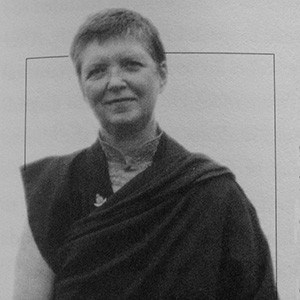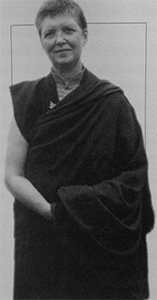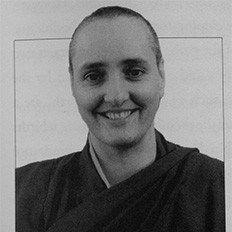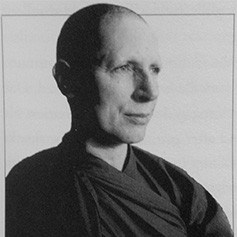Life in Gampo Abbey—Western style

From Blossoms of the Dharma: Living as a Buddhist Nun, published in 1999. This book, no longer in print, gathered together some of the presentations given at the 1996 Life as a Buddhist Nun conference in Bodhgaya, India.

Bhikshuni Tsultrim Palmo
Establishing a living place for monastics in the West is challenging and rewarding. Our community, Gampo Abbey in Nova Scotia, Canada, has gone through many changes over the years. It was founded by Chogyam Trungpa Rinpoche, who escaped to India after the abortive Tibetan uprising against the Chinese communists in 1959. By appointment of His Holiness the Dalai Lama, he became spiritual advisor to the young lama’s school which trained the young reincarnate lamas in India. Rinpoche received a khenpo degree, the highest scholarly degree. He then received a Spaulding scholarship and attended Oxford University, where he studied comparative religion, philosophy, and fine arts. He also studied flower arranging and received a degree in it from Sogetsu School. In England, Trungpa Rinpoche started to teach Dharma to Westerners, co-founded the Samye Ling Meditation Center, and learned to speak English fluently. After a car accident, he gave up his monastic robes to avoid Tibetan cultural trappings and the religious fascination of Westerners. He married an English woman and, at the invitation of his Western students, moved to the United States, where he taught at the University of Colorado and developed a friendship with the well-known Zen master Suzuki Roshi. He began to teach widely, establishing the Vajradhatu, Shambhala, and Nalanda organizations, which will be explained later.
In 1983, Trungpa Rinpoche decided to establish a monastic setting for his students and asked people to move to Nova Scotia from Boulder, Colorado. We found a farmhouse and barn on 220 acres on Cape Breton Island, a remote and quiet place. The closest village was a one-hour drive over a mountain. Ane Pema Chodron was asked to lead the abbey, and in 1984, a small group of us, ordained and lay, went to live there. By 1985, the property was paid for in full, freeing us from the burden of a mortgage. Also in 1985, Ven. Thrangu Rinpoche agreed to be our abbot, a position that Trungpa Rinpoche could not take because he was not a monastic. In our name, “Gampo” stands for Gampopa, the student of Milarepa who established monasticism in the Karma Kagyu lineage in the eleventh century and combined the yogic and monastic paths. “Abbey” indicates that it is not a monastery or a nunnery, for monks, nuns, and lay people live there. The nuns and monks practice, study, work, and eat together, although we live in two separate buildings.
Our first monastic program was led by a Chinese bhikshuni, Venerable Yuen Yi, who trained us strictly, but with humor. In subsequent years we were taught by a Western bhikshu, Lama Droupgyu; our abbot, Trangu Rinpoche; the German Theravada nun, Ayya Khema; the scholar, Dr. Herbert Guenther; Jamgon Kongrul Rinpoche; and Ponlop Rinpoche. In 1986, we had our first varsa (Pali: vassa, Tibetan: yarney), the rainy season retreat, and in 1987 we had training in playing Tibetan musical instruments, making tormas (ritual cakes), and creating sand mandalas. Since we learned these skills early on and we teach them, we no longer depend on Tibetan lamas to do this. In 1990, the first English language three-year retreat at our retreat center, Sopa Choling, began.
Since 1989, twice a year we have published The Profound Path of Peace (PPP), the journal of the International Kagyu Sangha Association of Buddhist monks and nuns. Copies are sent to Kagyu centers worldwide and are positively received.
The Program
Our monastic community has grown slowly but steadily over the years. By 1996, we had five bhikshus and four bhikshunis, plus others with lower ordinations. Every year some people take either permanent or temporary ordination. Twenty-four people finished the first three-year retreat (which actually lasted six years because people alternated six-month periods of being in and out of retreat!) in 1996, and the second three-year retreat at Sopa Choling began in 1997. All the Sopa Choling retreatants are ordained for the duration of their retreat. They are in strict retreat and literally separated from the world, including Gampo Abbey, by a fence. The only people authorized to enter the retreat area are the cooks, druppon or one who guides the retreat, and maintenance workers.
Bhikshus and bhikshunis, novices, people who are parmarabjungs (pre-novices with life-long ordination), and those with temporary ordination all live at Gampo Abbey. Some staff members come for six months or one year to work, practice, and study. In addition, there are program participants and visitors who stay for brief periods of time. Every lay person who comes to Gampo Abbey must take the five precepts, adhere to Gampo Abbey rules, and follow our daily schedule, which includes meditation. Everyone meets regularly with a meditation instructor.
We usually conduct four programs yearly for the general public—three for beginners and one for advanced students. In addition to teachings by Ane Pema Chodron and senior monastics, we invite visiting lamas and other teachers. We do varsa, the rainy season retreat, and two one-month dathuns each year. During these we meditate for nine or ten hours a day. In 1997, we began a one-month temporary monastic training for young adults ages seventeen to twenty-five. This gives them an alternative to music and drugs by providing intensive training in the Dharma in a monastic setting before they go to college or have a family. We adopted the idea of temporary ordination from the Theravada tradition, and Thrangu Rinpoche gave his consent and began to give temporary vows. Although temporary ordination is common in Theravada countries, it has not been given in the Tibetan tradition before. But we have found that it has a beneficial effect on those who take it, especially the young adults.
Our daily schedule begins with an hour of morning chanting—which includes the Four Dharmas of Gampopa, requests to the lineage, and the Heart Sutra—and silent meditation at 6:30 A.M. Except for chanting the five precepts in Sanskrit, all other chants and practices are done in English. After breakfast we meditate, either as a group in the shrine room or individually in our room. At 11:00 A.M. there is a optional study period. Everyone keeps silence until noon, when we have lunch. After lunch we work for four hours, and then gather for an hour of meditation and evening chanting. After supper there is a class or silent meditation. Lights go out at 10:00 P.M. Saturday is an unscheduled day, so we can sleep in and do whatever we want. Everyone, including the cook, has the day off. Sunday is all-day practice, and many people meet with their meditation instructor then. We keep silence all day and practice together in the shrine room. Often there is a talk in the afternoon.
Three of our monks are passionate about Dharma study, so our study department is strong and vital. We offer ongoing courses for shamatha (the practice to develop concentration) and ngondro (preliminary practices), often taught by Pema Chodron. Thrangu Rinpoche visits and teaches at Gampo Abbey about twice a year, and Ponlop Rinpoche and other teachers also instruct us. In 1996, Nythartha Institute, inspired by the monastic colleges, or shedra, in Tibetan monasteries, began. Its goal is to transmit the teachings of the Kagyu and Nyingma lineages to advanced Western students.
Gampo Abbey provides an environment and training for people who wish to explore the monastic path. The training has four stages. First one is a candidate. Men or women who are interested in becoming monks or nuns are asked to live in Gampo Abbey for a trial period of at least six months as staff members or as paying guests. Second is pre-novice—parmarabjung in Tibetan—a lifetime commitment in which one takes the five precepts: to avoid killing, stealing, unwise sexual behavior, lying, and intoxicants. The parmarabjung precept to avoid unwise sexual behavior includes being celibate. Instead of becoming a pre-novice, many people instead take temporary ordination, given for six months to one year, after which they usually leave the abbey and return to lay life. The third stage is being a novice—a sramanera or sramanerika. This ordination is given after the person has been a pre-novice for a year. Taking the novice vow is a lifetime commitment to monastic life. It is held at least three years before progressing to the fourth step, the full ordination as a bhikshu or bhikshuni. When Thrangu Rinpoche gives monastic ordination, the bhikshunis, along with the bhikshus, act as witnesses, a practice not found in the Tibetan community.
Monastic Rituals
As we learn in the Vinaya, there are three important monastic rituals: posadha, varsa, and pravarana. Since 1984, we have done all of these at Gampo Abbey, and now we use the English translations of these rituals. Posadha is done bimonthly, on the new and full moon, and its purpose is to revive virtue and purify whatever non-virtue has been created in connection with our precepts. Because it is a purification rite, posadha is done in the morning before eating. It proceeds as follows: the ghandi, a wooden instrument used since ancient times to call the sangha for posadha, is sounded. We take purification water before entering the shrine room, and then prostrate, recite sutras, and offer tormas. The lay people leave the room and contemplate their five precepts in another room. In the shrine room, the monastic leader reads the sutra of discipline, and the parmarabjungs and temporary ordained lay people do their confession. They then leave the shrine room and join the lay people. Next, the novices do their confession together and leave. Finally, the bhikshus and bhikshunis perform their confession, after which the Pratimoksa Sutra is read. At this point, everybody returns to the shrine room, and we recite the refuge and bodhisattva vows together and take the eight precepts for the day. Next we circumambulate the building—outside or inside depending on the weather—while playing musical instruments, and then return to the shrine room to dedicate the merit.
Varsa is the rains retreat instituted by Buddha Shakyamuni. During monsoon season, to avoid harming the crops and the many insects that grow at that time, monastics did not walk to the villages to collect alms or to teach. Instead, they studied and meditated in one place, usually a garden donated by one of the Buddha’s wealthy lay disciples. In this way monasteries or viharas slowly evolved. After the rains retreat, some monks stayed in the dwellings to maintain them until the next monsoon, and with time these gatherings grew into communities. In India, the rains retreat lasts three months and is held during monsoon time, in the summer months. In the Karma Kagyu tradition in Tibet, it lasts seven weeks, so at Gampo Abbey we also do it for seven weeks. Initially, our rains retreat was in the summer. However since 1997, it has been in the winter, which is the natural season for retreat in Canada. This is a strict retreat so boundaries are established, and except for people who shop for us, there is no coming and going. There are no telephone calls, no projects, and no work, except for maintaining the abbey. We keep silence and focus on our meditation practice and the study of Vinaya.
The third ritual, pravarana is held the last day of the rains retreat. It involves lifting this retreat’s special restrictions. Traditionally in Tibet, the nearby villagers came to the monastery the evening before pravarana, and the senior monastics gave Dharma talks throughout the night. In the abbey, all the ordained people give talks on the eve of pravarana. This is a wonderful opportunity for all monastics to give what is often their first Dharma talk in a friendly, non-critical atmosphere. We are very happy to keep the three essential monastic rituals at our abbey in the West.
Practicing the Dharma
Our training is both in the Karma Kagyu and Nyingma lineages, and our main meditation practices are shamatha and vipashyana, or calm abiding and special insight. At Gampo Abbey and Sopa Choling we follow Trungpa Rinpoche’s guidelines, designed for Western students. He observed that Westerners need a solid base of shamatha, the calm abiding or tranquility sitting practice, before starting other meditations. This practice is somewhere between the Theravada-style vipassana and sitting zazen, and we do it with eyes open. As our main practice, we do it for a minimum of four hours a day.
At Gampo Abbey, as at other Shambhala centers, people do this sitting practice for two or three years. After that, on the recommendation of their meditation instructor, every student attends a three-month course called Vajradhatu seminary. During this course, we study the three vehicles—the Theravada, Mahayana, and Vajrayana—and do shamatha practice. At the end, we are given permission to start the first of the Karma Kagyu preliminary practices, prostrations. Each of the ngondro, or preliminary practices, is done after finishing the previous one and each practice requires an oral transmission. Three people in our sangha are authorized to give such permission. After finishing the preliminary practices, a person can receive the Annutara Yoga Tantra transmission of Vajrayogini, which was initially given by Trungpa Rinpoche and is now given by his son, Mipham Rinpoche. After finishing the mantras for Vajra Yogini, we can receive Chakrasamvhara empowerment. At this point, we have been practicing meditation for a minimum of six years and are qualified to participate in the three-year retreat at Sopa Choling.
The most wonderful, and most difficult practice, is living in a monastery. For ordained people and those interested in a monastic life, the practice of living a communal life is very powerful. By taking vows we simplify our lives, and this allows us to direct all our energy to the practice of waking up from the sleep of ignorance. The environment and the strict schedule support this, and in that sense, it is easy to live in the abbey. On the other hand, it is very difficult, because we receive instant feedback and see our habitual patterns so clearly. In a monastery there is nowhere to run away, so we must work with our own minds. Our usual habit of blaming others for our pain does not work for long here, because this place is for meditation practice and Dharma study. We are constantly brought back to examine ourselves. When people hear the words “monastery,” “abbey,” or “nunnery,” they often have either a romantic image of a perfect, harmonious, saintly place, or a horrible image of an austere, joyless prison. Gampo Abbey, in reality, is neither. The physical environment is very beautiful, and the people come from different backgrounds and have different personalities. However, they share a common commitment and willingness to work on themselves in order to wake up.
For a while, I was the director of the community. This is also a great practice of serving others and of taking criticism gracefully and responding to it with wisdom. As in all Dharma centers, finding skillful means to communicate is a challenge, as is finding a balance between being too lenient and too strict, between letting people do what they are passionate about and having a real community. Giving commands with “shoulds” and “should nots” does not work with Westerners. They become unhappy and depressed. A leader is challenged to become skillful with people and to help them grow and become softer and less self-centered. There is no general prescription for this; each person has to be dealt with in a different way.
Organization
Shambhala is the umbrella organization founded by Trungpa Rinpoche and now led by his son Mipham Rinpoche. It contains three branches: Shambhala training teaches a secular path of spiritual training; Vajradhatu is the Buddhist branch of the organization, in which Gampo Abbey is included; and Nalanda is the branch that brings a contemplative perspective to the arts, health, education, and business. This includes Naropa Institute and the Nalanda Translation Committee.
Venerable Thrangu Rinpoche is the abbot of Gampo Abbey, and we receive instructions, ordinations, and empowerments from him. Similarly, the residents of Sopa Choling receive empowerments for the three-year retreat from him. Senior bhikshunis and bhikshus are authorized to give temporary ordination. Bhikshuni Pema Chodron is our spiritual director and main resident teacher. Beginning in 1997, we hired a Sopa Choling graduate to be the administrator.
The monastic council and the department heads aid in the administration of the abbey. The monastic council consists of all nuns and monks living at the abbey, including those temporarily ordained. It meets on posadha days and makes general decisions about policy and view. Twice a month the department heads gather to discuss finance and construction and to make day-to-day decisions to assure the smooth running of the abbey. Every Monday in a house meeting of all residents, everyone is informed about short- and long-term plans. We exchange opinions and information, introduce new residents, and say good-bye to old residents.
Gampo Abbey is a non-profit organization in Canada and the United States. Our income comes from three sources: 1) donations; 2) programs, visitor fees, and residents’ contributions; and 3) royalties from Ane Pema Chodron’s books and recordings, fundraising done by monastics, and offerings received from teaching. All monastics live free at the abbey. It is their home and they govern it. Monks and nuns who do not have any income receive a $35 monthly stipend for personal needs. All non-monastic staff are asked to contribute at least $5 daily, if they are able, to help with the food bill.
Our main expenses are food, maintenance, and construction. We have a large garden that supplements our food during the summer. We are vegetarian, but occasionally eat fish. We use wood for heating, and in the near future we will generate our own electricity from a stream on our property.
We plan for monks and nuns to stay, practice, study, and work at Gampo Abbey for hundreds of years. Meanwhile, in the immediate future we will stop the physical expansion and modernization of Gampo Abbey for a few years and concentrate on monastic activities and programs. We will also organize a yearly program for temporary monastics and will continue to study the Vinaya. The three-year retreats at Sopa Choling will continue, as will the Nythartha Institute. We would like to make Ane Pema Chodron’s teaching more accessible to the general public by hosting more programs each year, and to propagate the Dharma outside of the Abbey by making ourselves more available for teachings. There is interest in teaching meditation in prisons and working with the dying, as well as in inter-religious dialogue.
Gampo Abbey has a slogan: “Projects are not important—people are.” This reminds us that we are here to serve and to practice waking up, not to make an ideal abbey. Living at the abbey brings us down to earth and blows away any sand castles we may have in our minds. Gampo Abbey is a friendly place that has helped many people. We take pride in what has occurred thus far and are extremely grateful for all the wise teachers who have helped us to evolve. Now we look forward with confidence, but also with the knowledge that we have just begun and have a long way to go.
Tsultrim Palmo
Bhikshuni Tsultrim Palmo was born in Poland and received a degree in psychology before doing further study in Gestalt Therapy. She raised two children, who are now grown, before she received the sramanerika vows in 1982 and the bhikshuni vows in 1984 in Hong Kong. Beginning in 1986, she did the traditional three-year, three-month retreat at Kalu Rinpoche’s center on Saltspring Island, Canada. She served as director of Gampo Abbey in Canada for some years and is now retreat master for the present three-year retreat there.


